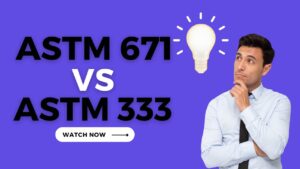1. ASME B31.3 Applicability
What types of fluids does ASME B31.3 cover?
Explanation: ASME B31.3 covers a wide range of fluids, including gases, steam, air, water, and more, not limited to hydrocarbon services.
2. Piping System Design
What aspect of piping systems does ASME B31.3 focus on in various process plants?
Explanation: ASME B31.3 focuses not only on individual piping components but also on the overall system design and integration within process plants.
3. Fluid Services Coverage
What types of fluid services fall under the scope of ASME B31.3?
Explanation: ASME B31.3 covers a wide range of fluid services, including gases, steam, air, water, raw materials, finished chemicals, and more.
4. Packaged-Equipment Assemblies
What does ASME B31.3 encompass regarding piping within packaged-equipment assemblies?
Explanation: ASME B31.3 encompasses piping that interconnects pieces or stages within a packaged-equipment assembly, ensuring holistic guidelines for design and integration.
5. Overall ASME B31.3 Purpose
What is the main purpose of ASME B31.3?
Explanation: ASME B31.3 serves as a comprehensive guide for the design, materials, fabrication, erection, inspection, and testing of piping systems in various process plant applications.
6. Process Plant Inclusion
Which of the following is NOT a type of process plant where ASME B31.3 guidelines apply?
Explanation: ASME B31.3 applies to various process plants, including pharmaceutical facilities, cryogenic processing plants, and textile mills, but not exclusively to automotive manufacturing plants.
7. Fluid Services Inclusion
Which of the following is NOT within the range of fluid services covered by ASME B31.3?
Explanation: ASME B31.3 covers a wide range of fluid services, but it does not include electrical power transmission fluids within its scope.
Short Article on Scope Inclusions of ASME B31.3
The scope of ASME B31.3 is quite broad, encompassing a wide range of piping systems and fluid services. It’s important to note that ASME B31.3 is not limited to just hydrocarbon services, but rather applies to piping systems that transport a variety of fluids, including:
• Raw, intermediate, and finished chemicals • Petroleum products • Gas, steam, air, and water • Fluidized solids • Refrigerants • Cryogenic fluids
The scope also extends to piping that interconnects pieces or stages within a packaged-equipment assembly. This means that ASME B31.3 guidelines apply not only to individual piping components but also to the overall piping system design and integration within larger equipment assemblies.
Here’s a summary of the key aspects of ASME B31.3’s scope:
- Process Plant Piping Systems: ASME B31.3 focuses on piping systems found in various process plants, including petroleum refineries, chemical plants, pharmaceutical facilities, textile mills, paper mills, semiconductor manufacturing plants, cryogenic processing plants, and related process plants and terminals.
- All Fluid Services: The code’s applicability extends beyond just hydrocarbon services, covering a wide range of fluids, including raw materials, intermediate products, finished chemicals, petroleum products, gases, steam, air, water, fluidized solids, refrigerants, and cryogenic fluids.
- Packaged-Equipment Assemblies: ASME B31.3 also encompasses piping that interconnects pieces or stages within a packaged-equipment assembly. This ensures that the code’s guidelines are applied holistically to the overall piping system design and integration within larger equipment assemblies.
In essence, ASME B31.3 serves as a comprehensive guide for the design, materials, fabrication, erection, inspection, and testing of piping systems in various process plant applications, catering to a diverse range of fluid services and equipment configurations.
Table of Contents
Don’t miss the Course on Effective Isometrics Management: Check Now
Enrollment Link
Recommended courses (Published on EPCLand)
- Complete Course on Piping Engineering
- Basics of Piping Engineering
- Piping Layout Engineering
- Piping Material Engineering
- Piping Stress Analysis
- Material Requisitions
- Piping Material Specifications
- Valve Material Specifications
- Plant Design & Layouts-OISD 118
- Isometric Management
Library of Technical Articles
Don’t miss out the collection of 15+ articles on following topics:
- Basics of Oil and Gas Industry
- Valves
- Testing
- Tank
- Piping Bulk Items
- Pipe
- Metallurgy
- Piping Materials
- Layout
- Instrumentation
- Heat Exchanger
- Type of Contracts
- Codes and Standards
- ASTM Standards
- Articles on Piping Specialty Items
Video details of Complete Course on Piping Engineering
Why Enroll in the EPCLand
Proven Track Record– PTR
Activities & Achievements before launching EPCLand
- Published more than 50+ short courses
- 3000+ Enrolments
- More than 3,500,00 Minutes of watch hours in the last 2 years
- 4000+ Students in 100+ Countries
- Rating of 4+ out of 5
- 1000+ YouTube Videos
- 8K+ Subscribers
What Students will Learn
- Codes & Standards of the Energy Sector
- Piping Material Engineering
- Piping Layout Engineering
- Stress Analysis
Interesting facts
- All the published courses have been developed by Industry Experts with more than 2 decades of experience
- Content is based on Practical experience and real-time problems.
- Content is designed and organized in such a manner that it can be easily grabbed.
- Complete website, Blogs and Quiz sections are Planned, Designed and published by myself (About me: Atul Singla)
- Complete flexibility of Time & Location, Students can access the content from anywhere & anytime
- Moreover, once enrolled, the content can be access as many times as you want, which helps in understand the fundamentals in a better way.
Conclusion
In conclusion, our courses are meticulously crafted by industry experts with over two decades of hands-on experience. The content is rooted in practical knowledge, addressing real-time problems. The material is thoughtfully designed and organized for easy comprehension. Every aspect, from the website to blogs and quizzes, has been planned, designed, and executed by Atul Singla, ensuring a comprehensive and seamless learning experience. With the flexibility of accessing the content at any time and from any location, students have the freedom to learn on their terms. Furthermore, enrollment grants unlimited access, allowing learners to revisit the material as often as needed, fostering a deep understanding of the fundamentals.



